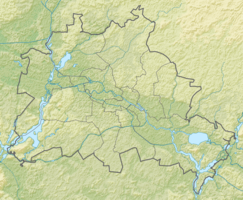Köpenick Castle Park
| Köpenick Castle Park | ||
|---|---|---|
| Park in Berlin | ||

|
||
| Basic data | ||
| place | Berlin | |
| District | Koepenick | |
| Created | as a palace park in the 17th century | |
| Newly designed | in the 1990s | |
| Surrounding streets |
Müggelheimer Strasse (north) to the east, south and west form the park boundaries |
|
| Buildings | Castle, Castle Church and Castle Bridge | |
| use | ||
| User groups | Pedestrian traffic , leisure | |
| Park design | Castle gardening (17th century) Köpenick green space office (21st century) |
|
| Technical specifications | ||
| Parking area | 18,600 m² | |
|
52 ° 26 '34.8 " N , 13 ° 34' 22.8" E
|
||
The Köpenick Castle Park is located on the Köpenick Castle Island. It developed from a park belonging to the castle in the 17th century in connection with the constant conversion of the castle and the island into a well-tended green area.
history
Baroque garden
The park around the castle was created around 1690 on an artificial fill of the island, at the same time as the castle was built. The palace gardener laid it out as a baroque park with strictly cut bushes, flower beds and a central axis running south. Broderie parterres were designed on both sides of this axis . Alleys ran along the banks of the Dahme and Frauentog, and there were seats to linger.
There was direct access to the park from the south wing of the palace and the structure harmonized well with the green space.
In the summer of 1712, an aloe ( Agave americana) with a height of almost ten meters caused a sensation . It had 44 branches and 7,277 flowers. The agave went down in the history of the palace park as a "miracle aloe" and was admired by the Russian Tsar Peter the Great as well as by other important visitors to the park.
Landscape park
The garden, which was previously in good condition, became increasingly overgrown after the death of Duchess Henriette Marie von Württemberg-Teck (1782). Between 1804 and 1806 the baroque palace garden was redesigned into a landscape park under Friedrich Wilhelm Carl von Schmettau , the palace complex had been left to the military treasury for use by the royal domain administration. After Schmettau's death, the park was returned to the ruler's court and overgrown again.
In 1963/1964 the park was reconstructed according to plans by the Hagen Lichey garden collective. The landscape character of the green area and the riverside paths were retained. A low wall was built to demarcate the castle courtyard. In addition, two rows of linden trees were planted at the level of the courtyard . The woody vegetation in the castle park still indicates the influence of the lowlands.
In the park, at the level of the café, there is a black walnut as a designated natural monument . The tree with a trunk circumference of 3.43 m is estimated at 150 years. It is around 15 m high and has a pronounced, round crown.
Description and usage
The main park path runs not far from the water, which offers a good view. In the middle of the park there is a larger open area that allows an unobstructed view of the castle. This has been preserved from the first park design. The castle courtyard is also used for events and concerts, especially in the summer months. In the summer of 2018, for example, the winegrowers' summer took place in the facility , which began in 2014.
Art and memory in the park
There are several sculptures and memorial plaques in the palace park :
At the western entrance to the park stands the statue of Meleager , carved from sandstone , which is dated to the end of the 17th century. (A copy of the statue was placed in the castle courtyard.) From the first design period, some cast-iron vases from the early 18th century have been preserved and planted. In the park there are monuments to Marianne von Schmettau , as a sandstone portrait urn with a crying putto on a pedestal and to Johann Julius Hecker (1707–1768). Hecker was the founder of the first Prussian teacher training college in 1748. The sandstone stele was donated in 1898 on the occasion of the 150th anniversary. At the bottom it shows the bas-relief of a seminarist paying homage , on top there is a bronze relief bust that was designed by the sculptor Friedrich Volke . Several modern sculptures were erected within the park area, especially in the 20th century .
The information about the Wunderaloe is designed as a memorial plaque .
Web links
- Köpenick Castle Park at www.berlinstadtservice.de.
Individual evidence
- ↑ a b Joachim Schulz, Werner Gräbner: Berlin. Capital of the DDR. Architecture guide GDR. VEB Verlag für Bauwesen, Berlin 1974; P. 140.
- ↑ Description corresponds to some historically transmitted images of the castle island.
- ^ A b Institute for Monument Preservation (Ed.): The architectural and art monuments of the GDR. Capital Berlin-II . Henschelverlag, Berlin 1984, p. 273 ff .
- ↑ Die Schwarznuss on the Köpenick Castle Island at www.berlin.de; accessed on May 6, 2020.
- ↑ Ralf Drescher: From August 16 to 18 there will be a proper celebration. , Berlin Week , August 12, 2019.


